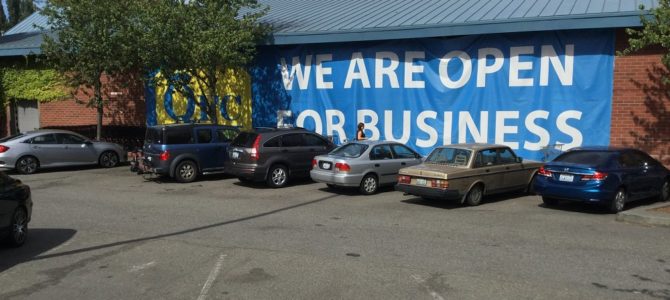
The COVID-19 pandemic will affect both aggregate demand and aggregate supply in the U.S. economy. How much will aggregate demand change? To what extent will the stimulus—the Federal Reserve, temporary tax cuts, increased government spending—help? The disparate fields of sports economics and consumer economics can give us some clues.
COVID-19 could cause disruptions in the pattern and composition of both personal and aggregate demand. Some markets will be hit hard: restaurants, conventions, and other travel-related businesses. Decreases in demand in those markets may not be fully offset by increases in demand in other areas.
While people are spending less on one sector of the economy, however, they are spending more on others. In the very short run, people are increasing their spending on toilet paper, hand sanitizers, long shelf-life pantry goods, bottled water, N95 masks, and so on. But you can’t buy stuff that doesn’t exist. No stimulus can completely offset the effects of the virus.
To look at how markets will respond long-term, it’s helpful to draw analogies from other economics knowledge. Here’s what we can learn from changes in buying patterns related to new sports stadiums often financed by taxpayers.
It is often alleged that locally financed sports venues increase income and spending in the local area. Sports economists have studied this for several decades. The conclusions are almost unanimous. Publicly financed sports venues usually cost taxpayers more than the benefits to residents of the surrounding community.
The Wuhan Flu is shutting down many, many public events. The worry is the opposite of the public stadium claim of increased spending. In this case, the story is that people will stay home and spending will fall. But this may not be true. Let’s continue our discussion of publicly owned stadiums to see why.
The short answer is there is no extra aggregate spending. The approximate amount of net new spending is zero. The key word is net. People will spend more at the sports arena built with taxpayer dollars. But they will also spend less on other entertainment.
For example, suppose you’re considering buying season tickets for an NBA team, say, the Philadelphia 76ers. Prices start at $9,200. You may decide to spend a few weeks in Hawaii instead. Think of a consumer having a fixed budget for fun. Spending more on season tickets to the opera means spending less on other amusements.
The idea of a fixed budget for fun works in both directions. What people don’t spend on going to a professional baseball game, they will usually spend elsewhere. Perhaps they will subscribe to some expensive streaming video channels. They will undoubtedly do more online shopping.
Demand for video conferencing and e-learning services is already skyrocketing. Many universities are switching to online classes. The only question is whether increased spending in these areas offsets the decline in spending in other markets. The Wuhan Flu will undoubtedly cause a decrease in spending. But it may not be as dramatic as some are forecasting.
This idea is the crux of Nobel Prize-winning economist Milton Friedman’s well-known permanent income model of consumption. Friedman’s original statement of his model was, “permanent consumption spending is a function of permanent income.”
What does he mean by “permanent income?” Think of it as your average monthly income over the past two years. (In reality, it is the income you expect to earn over your planning horizon, a number of future years.)
Friedman said people respond to short-term changes in their income by adjusting their wealth. During periods of above-normal income, a household will increase wealth by saving, paying off debt, or both. If income is below normal, folks will decrease wealth by saving, adding to their debt, or both.
In other words, people try to maintain a given lifestyle (permanent consumption) when faced with fluctuations around their permanent income. Even if the Wuhan Flu throws you into unemployment, you are likely to remain jobless for several months, not years and years. You will spend savings, increase debt, and try to maintain your current standard of living.
The main point from both fields is that total spending is likely to fall less than feared. After all, people are selling stocks like crazy. That cash has to go somewhere. Part of it will be spent supporting current lifestyles.
And demand will largely be deferred, not eliminated. There may be a brief downturn in the economy, but look for a burst of spending once this crisis is over.
An example will clarify these abstract models. Consider Chris, a restaurant worker. Business has fallen way off. Chris has been laid off, so income is now zero.
Chris will first spend some savings (wealth). In addition, Chris will borrow (go into debt). When Chris gets a new job, eventually the debt will be paid off and savings will be restored. The upside is that business will probably boom after the crisis has passed, so Chris can earn more income.
This points to an important role for government. Suppose Chris was just hired on a first job. He has no savings, no credit history, meaning Chris is out of luck.
An appropriate government action is to keep Chris alive. Direct financial grants, perhaps including some loans, is the appropriate remedy. This does not necessarily mean replacing all of Chris’s income. But when catastrophic events occur, government should step in and help the most vulnerable.
This might seem like a big job. It really isn’t. The IRS has all the data about Chris (except wealth and total debt). They should be able to screen the data in a hurry, perhaps using ZIP codes as a rough measure of wealth. And if there is one area where the federal government excels, it is writing checks.
In other words, because of coronavirus consumer spending may fall somewhat, for a time, because there are fewer choices of goods and services to buy. But, as economist Jodi Beggs put it on Twitter:










